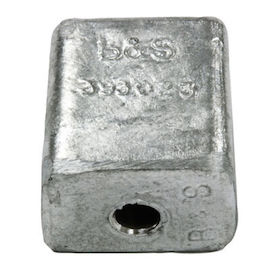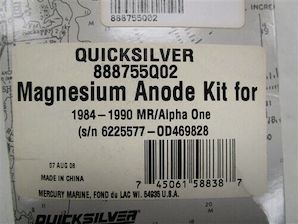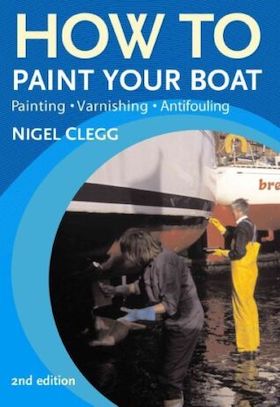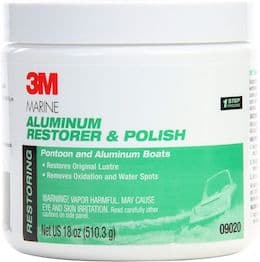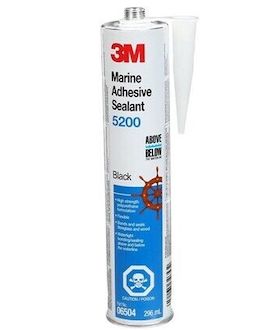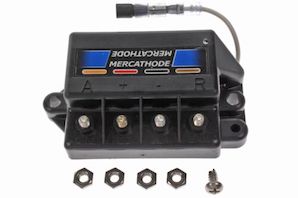
-----
Aluminum boat, electrolysis/corrosion
Q. I have an 18 foot aluminum boat powered by a 75 HP Honda outboard. I run periodically in the salt water with the rig being about 6 years old. Within the last two years. I have noticed "pitting" on the transom with a white, powdery "puss looking" secretion coming from the pitted area. I have wire brushed the area and filled in with JB Weld
⇦ on
eBay or
Amazon [affil links]
but it seems to have come back. I suspect I am suffering from some sort of electrolysis.
What should I do to repair the "pitted areas"...and what can/should I do to prevent it from reoccurring?
Thanks
- Yorktown, Virginia
2004
A. Corrosion is a pretty normal phenomena that doesn't necessarily require electrolysis (galvanic corrosion). I'd paint the transom with either a metal-free aluminum priming paint or, if you can buy it and are really desperate, an organo tin paint, TBT (this is truly biohostile stuff, and is allowed only on aluminum if at all). You also can connect zinc anodes to the boat to protect the aluminum as well.

Ted Mooney, P.E.
Striving to live Aloha
finishing.com - Pine Beach, New Jersey
 I have the same pitting problem with my Tracker. There is plywood in the transom to support the motor. This should be marine grade, and be sealed. Mine is not marine grade, and it was not sealed. The plywood gets water logged with salt water, and a chemical reaction caused the pitting and oozing. I have found no solution.
I have the same pitting problem with my Tracker. There is plywood in the transom to support the motor. This should be marine grade, and be sealed. Mine is not marine grade, and it was not sealed. The plywood gets water logged with salt water, and a chemical reaction caused the pitting and oozing. I have found no solution.
- Marlton, New Jersey
Ed. note: Once you've put pressure treated wood and its copper-rich chemicals in there may be no good solution. But at least you've warned others not to do it :-)
! I also have a 99 Tracker and the white has turned to holes. I have heard this transom corrosion being a problem big-time on Trackers. They won't sell me another boat. I am repairing it by stripping to the metal using vinegar ⇦in bulk on eBay or Amazon [affil links] to stop it. Then I am going to use some fiberglass filler. Add anodes, then prime with a special aluminum primer ⇦ on eBay or Amazon [affil links] then paint with some sort of bed liner paint. And then hope I get a few more years out of it.
Robert Sullivan- Maricopa, Arizona
Q. Which is the preferred anode to use on an aluminium boat below the waterline for use in salt water. Aluminium or Zinc anodes and why is this so.
Peter McmullanCaptain - Asker, Akershuus, Norway
2005
A. The purpose of sacrificial anodes is to corrode preferentially over more noble metals. Therefore, to work, the sacrificial anode has to be a DIFFERENT metal (and one lower on the corrosion scale) than the one being protected. So, the answer to your question is Zinc - a sacrificial aluminum anode would do little to nothing depending on alloying factors.
That being said, magnesium is even lower than zinc and may provide you with better protection since zinc and aluminum are quite close together (zinc however works great with other, higher, metals).
See thread 51262, "Zinc boat anodes not working!" for more info.
Good luck!
Compton, California, USA
Q. I have a Triton DV176 sport about a year old and use it in fresh and salt water. It is equipped with zinc anodes. It is normally stored on a trailer or boat lift. After research on the web I am convinced the primary issue is crevice corrosion which to this point is not too bad. I have recently sanded and repainted the affected areas. However, after my research I think a better answer might be to sand to bright metal and then leave unpainted so a protective barrier will form on the bare aluminum. Does anyone know the answer?
Steve Smietana- Chesapeake, Virginia
2006
A. No, Steve, painted aluminum is far more corrosion resistant than bare aluminum. Although it is true that shiny aluminum will very quickly oxidize, that thin oxide film doesn't offer much corrosion resistance. Anodizing is an electrochemical process that can build a very heavy and uniform oxide film that offers significant corrosion resistance, but it's more of a factory process than something you can do on your own boat.

Ted Mooney, P.E.
Striving to live Aloha
finishing.com - Pine Beach, New Jersey
Ted,
Thanks for the quick feedback. I have taken the bad spots down to bare metal, used a primer coat and the repainted. Any thoughts on how to best prepare the metal (5052 H34 Aluminum) in addition to the above. Most spots were caught very early and do now show pitting after sanding. One or two spots did progress to the point of some pitting. Again, thanks for your last response.
- Chesapeake Virginia
Ideally, aluminum should be chromate conversion coated before priming or painting. Alumiprep 33 ⇦ on eBay or Amazon [affil links] followed by Alodine 1201 ⇦ on eBay or Amazon [affil links] is a fairly common process -- but chromates are carcinogenic so this might be best left to professionals. You might inquire of Chemetall, Macdermid, or Henkel about a "chromating pen", but I don't know if they sell it to non-industrial customers.

Ted Mooney, P.E.
Striving to live Aloha
finishing.com - Pine Beach, New Jersey
![]() Ted,
Ted,
Thanks for your feedback.
- Chesapeake, Virginia
 This is a very common problem as Robert stated earlier. Initially I thought that I was at fault with my 2002 Tracker boat when I started to notice the same pitting. I replaced the zincs with little affect and came to the same conclusion that the plywood in the transom had absorbed Salt water even though I took all the precautions of power washing and scrubbing the entire boat after every exposure. The only solution is to replace the current plywood transom with a poly board and seal it after the effected area is cleaned. I have been painting several areas around cleats, etc. with a primer called Primocon ⇦ on
eBay or
Amazon [affil links]
. It appears to working well for now and will be painted on the transom. It is unfortunate and many Bass Pro Shop Tracker consumers are reporting this issue on the deaf ears of the manufacturer. Best of luck and happy fishing. Chris
This is a very common problem as Robert stated earlier. Initially I thought that I was at fault with my 2002 Tracker boat when I started to notice the same pitting. I replaced the zincs with little affect and came to the same conclusion that the plywood in the transom had absorbed Salt water even though I took all the precautions of power washing and scrubbing the entire boat after every exposure. The only solution is to replace the current plywood transom with a poly board and seal it after the effected area is cleaned. I have been painting several areas around cleats, etc. with a primer called Primocon ⇦ on
eBay or
Amazon [affil links]
. It appears to working well for now and will be painted on the transom. It is unfortunate and many Bass Pro Shop Tracker consumers are reporting this issue on the deaf ears of the manufacturer. Best of luck and happy fishing. Chris
- Gloucester, Virginia
Q. I have been suffering after having purchased a used Starcraft aluminum boat. During my first year I noticed the pin holes and corrosion. I stripped the paint off and drilled each area to get back to clean, thicker metal. Then I used the aluminum repair putty and jammed it into the holes. I peened each hole in thinking that when the putty dried, it could then be sanded and painted. Well, I did not get to paint the transom after the hole plugging exercise and I finally got ambitious enough to try it again this season. To my disappointment I found more holes. I am baffled because I only used the boat twice last year and it just sits on a trailer and rots. I need some help from anyone who has been successful in dealing with this. By the way, I redrilled, reputtied and now wait for the putty to dry (three days and still waiting). I'm sick about this. Thanks for listening.
Kim Kanisboater - Piscataway, New Jersey
2006
Q. We are experiencing significant corrosion to the hull (below water line)of a pontoon boat. The pitting is spaced approx. 3 inches apart over the entire aluminum surface. Others in our marina are also experiencing this for the first time. We believe it is caused by stray current(s) in the marina water.
If we try to solve the problem by adding a large sacrificial anode plate to the stern, can it be attached directly to the aluminum hull or should there be a non-metallic barrier inserted between the metal surfaces, and then a separate bonding cable attached to all the aluminum components?
Retired - Penn Valley, California
2006
A. I have been researching preparing a pontoon boat for saltwater use on another site. One of the users suggested that the plywood on a newer pontoon boats is pressure treated with a chemical containing copper. If the wood gets wet then a current is created between the pontoons and the wood creating corrosion. It is possible that the transom issue is similar. Replacing the wood with another material sounds like it could help.
Jack Maris- Chicago, Illinois
! I am a commercial fisherman and fighting aluminum electrolysis has become a way of life...and everybody (fishermen) have different ways to fix it, yet we all find electrolysis never sleeps and the battle goes on...
First off prevention from the start is the key...protect new aluminum with a good zinc duster
⇦ on
eBay or
Amazon [affil links]
and bottom paint. Also sealing all gaps with 3M 5200 marine sealant ⇨
is key and Zinc the hull or even hang a zinc wired to the hull over the side during short stays in the water.
Right now I am restoring a 14' aluminum Lund skiff that was abandoned for ?years and has serious electrolysis cancer;
30+ pin holes, 6 1-2" holes in the actual hull itself, and lots of areas of pitting looking like the skin of an orange from the waterline down.
My plan of attack; Taking the surface down to bare aluminum, rinsing the surface and letting it dry, scrubbing the surface and pitted areas with a strong vinegar/water mix and a wire brush.(there are sprays I've used in the past that oxidize the bare aluminum but I can't seem to remember what they are...breathing too much aluminum dust I guess).
Then, brushing all areas with acetone
⇦ on
eBay
or
Amazon
[affil links] Warning! Flammable!
and sealing all seams with 3M 5200 and filling all holes with a good marine epoxy.
Next paint surface with zinc dust.
I am going to try spraying the bottom with typical truck bed liner and there are a lot of brands out there, Rhino liner, Line-X, but there about $12/sq. ft. applied by the shop.
I'm going to try "Al's Bed Liner". Its do it yourself cheaper $80/gallon + $45 for the sprayer/hopper and covers an area 22 sq. ft. @ 1/16".
Don't want the boat to stay in the water too long to avoid barnacle growth but grass/slime should pressure wash easy.
Going to hang a zinc when not in use. Good Luck to all fighting similar problems. OUT.
Commercial Fisherman - Friday Harbor, Washington
2006
A. I rebuilt my transom with TREATED plywood and never put it in the water. The pits appear like a very small bullet hole coming from the inside and forcing the metal out. Since it has not been in the water and has not had a battery installed and is sitting on a trailer, I do NOT believe its caused by galvanic action due to water contact. It appears to be the chemicals used to treat the plywood. My guess is your transom was repaired with treated plywood.
Henry Nasset- Grand Forks, North Dakota
Q. Does anyone have any suggestions on how to repair pinholes in an aluminum boat? Someone suggests Rhino Lining spray but not sure that would correct the problem and prevent it from leaking in under the lining if sprayed on the inside. Not sure how it would hold up if sprayed on the underside. Dealer could not guarantee anything. Anyone had any experience repairing these holes or with Rhino Spray?
Richard Richardsonboating hobbyist - Midway, Georgia
May 4, 2010
A. Hi, Richard. I would not go out in water more than knee-deep in a boat where holes were repaired with Rhino lining :-)
It's not made for that purpose. I believe Michael G was talking about using the lining as a coating or covering
(like paint), not as a plug material to seal holes.
The first thing is to stop the pinholing, with anodes, pretreatment, paint, eliminating any copper-bearing bottom paint, eliminating any pressure treated wood or other situations that cause galvanic corrosion.
Then a marine grade sealant like 3M 5200 ⇨
could probably be used for a few tiny pinholes. Good luck.
Regards,

Ted Mooney, P.E.
Striving to live Aloha
finishing.com - Pine Beach, New Jersey
A. I have an old Starcraft since 1981. Had the same problem. except it was effecting the rivets not the aluminum on the boat. I paint the bottom with aluminum undercoating made by Rustoleum . Then bottom Paint. Aluminum likes to be covered. Then I put a zinc block on it. Problem solved. I have no problems. Change the block every year just like the old wood boat I had. Caulk, I only use Phenoseal. I know what the label says. But it is the best I have found. Yes better than silicone.
Another crime I found. Never put the battery on the aluminum. Make sure you have it in a battery box out of the water in the bilge.
PS never use a zinc chromate paint or for that matter any oil base paint. The rustoleum paint I use is all latex undercoating.
Johney Seg- Pennsauken New Jersey
April 4, 2011
A. One other thing. Most the time the problem is not even your boat. There could be an electrical current in the water from another source. Most are looking for a problem in their boat. If your neighboring boat uses there metal boat for a ground or a ground cable from a house. All will cause a current. If it were one thing causing the problem we would not be having this discussion. We would know what it is. There are many reasons. But be sure, the more coats you cover the aluminum the longer it will last.
Johnny Seg- Pennsauken New Jersey
I have a Triton VT-17 bass boat with problems of the aluminum corroding and pitting. Especially on the transom and aft bottom of the hull. The boat is only used in fresh water. I would like to mount an anode to help in dealing with the corrosion. If I understand what I've read on the subject of anodes, an anode of magnesium works best in fresh water instead of zinc. If this is so, where is a good location to mount one and how can it be mounted to the boat?
Everett HillBoat owner who loves fishing - Indian Mound, Tennessee
November 25, 2010
Q. We live in the tropics of Australia, my 8.5 m aluminium boat was on its trailer over the wet season the boat was held horizontally and I suspect fresh rain water had accumulated in the hull over a 5 month period I have since opened the floor with soft patches the holes appear with a small mottled area around it concentrating in the middle with a 2 mm 1/8" holes straight through the hull. Question is it corrosion or electrolysis and how do I fix it please?
Laurence McKenzieAustralia - Kununurra west Australia
April 13, 2011
First, a confession: I leave my Bennington pontoon boat in the salt/brackish water full time, tied to a floating dock. Why? Because I find that one of life's great pleasures is casting off the lines and going out into the sheltered waterways without trailering the boat. HOWEVER, I now see that my toons are pitting. There are some pinholes forming. From the other posts I now see what I need to do, in terms of protecting the 'toons with sealant and even the use of anodes.
My fundamental question, though, is this: Is it unreasonable to have a pontoon boat in the salt/brackish water full time, even with those precautions? Must I abandon aluminum for fiberglass then? Thanks!
by Stephen F. Pollard
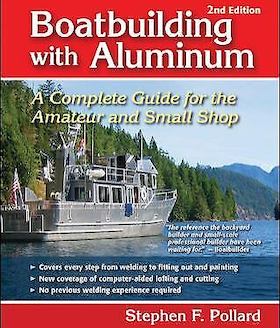
on eBay or Amazon
or AbeBooks
(affil link)
- Charleston, South Carolina, USA
May 7, 2011
A. We bought a pontoon boat with aluminum hulls that had suffered serious corrosion, probably from electrolysis. We filled the hulls with water to find and mark the leaks. After the hulls dried out, repairing began. Only one hull had leaks, into which we put screws to plug the small holes. We then filled the hull with several cans of insulating foam, just in case of catastrophic leaking, to prevent the boat from sinking/flipping. Then we painted the hull with truck bed liner over the unpainted exterior hull, right over the heads of the screws. (I can't remember what prep we did to the hulls before applying the truck bed liner paint. Maybe sanded, or wiped them down with acetone?) The pontoon boat has been in the brackish water for about 4 years now, without any leaking, and no attached anodes. No signs of corrosion, leaking, or problems so far. We use it occasionally when guests show up.
Donna Browning- Escatawpa, Mississippi
August 5, 2011
A. Hi guys,
Firstly, a few of you have indicated vinegar to clean aluminium.
That's fine as long as you thoroughly clean it off afterwards, as any vinegar residue will eat straight through aluminium. Over time it will make your aluminium brittle and accelerate corrosion.
- Victoria Australia
August 29, 2011
Q. You mentioned installing a zinc anode to an aluminum boat. Where should it go?
Mike ScaffidiHobbyist - Biloxi, Mississippi
August 31, 2011
A. Hi, Mike.
I'm no marine engineer, so will be happy to be corrected, but I don't think it matters much. The anode has to be constantly wetted, and it must be in metallic contact with the metal it is protecting, but that's about it. Try putting one on each end of the boat.
Regards,

Ted Mooney, P.E.
Striving to live Aloha
finishing.com - Pine Beach, New Jersey
August 31, 2011
Q. I have a Starcraft Fishmaster 196 Aluminum hull, painted by the manufacturer; it's 10 years old. I noticed a few small holes in the hull up front and on the transom. Based on what I've read on your site, everyone says install Zinc Anodes... My Question is do a need to grind down to bare Aluminum on the hull prior to installing the Anode in the Transom area the size of the 3 x 8 inch Anode or will the bolt holes used to hold the Zinc Anode stainless steel bolts be enough. I also noticed on the large Anode I bought the bolt holes are made of Brass, which I wondering should I also be using Brass bolts?

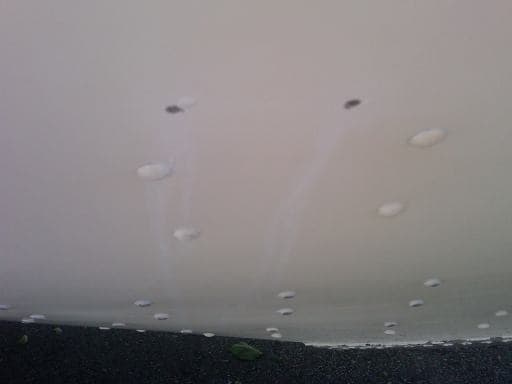
Fisherman - Raymond, New Hampshire
September 6, 2011
Q. Hi Ted, I have a pitting problem with my aluminum transom,
some of the pits are small holes, I was reading your earlier posts about Chromate pen; can this be used as a filler?
- Monroe, North Carolina, USA
October 19, 2011
A. Hello, Gene.
Sorry, Chromate is not a filler, it is only an aluminum pretreatment.
Regards,

Ted Mooney, P.E.
Striving to live Aloha
finishing.com - Pine Beach, New Jersey
Q. Hi Ted, thanks for the quick response to my question, I have one other question about anodes, I have installed a new zinc anode to my outboard engine, can I also install another anode to the boat itself.If so where would I attach it? Could it be attached to the transom on the inside at the bottom or does it have to be on the water side and be in the water at all times?
Thanks, Gene Allen
- Monroe, North Carolina, USA
October 23, 2011
A. Hi again, Gene.
Think in terms of principals, that the way the anode protects is by itself, plus the metal of the boat, plus the conductive salt water, together comprising a battery-like circuit. The anode must be electrically attached to the metal to protect it, and it must be exposed to the salt water. No problem having an anode on the motor and an anode on the boat.
Regards,

Ted Mooney, P.E.
Striving to live Aloha
finishing.com - Pine Beach, New Jersey
October 24, 2011
Q. Ok...I'm ready to buy a SunTracker in Cape Coral..What do I need to know to protect the pontoons in brackish/saltwater before I even put it in the water....Thanks....Pat
Pat Moorison- Cape Coral, Florida, USA
November 13, 2011
Q. Buying a Pontoon Boat to be used in Saltwater. If it is mostly kept on a trailer do I need to paint the toons? Worried about the trailer board contact with the toon that I will not be able to rinse.
Also if I do keep it in saltwater is painting pontoons and zincs on each toon and engine enough or Do I also need to add a zinc to hang from boat that will be attached to the negative battery terminal
- Palm Beach Gardens Florida USA
November 14, 2011
A. Hi, Rick.
Painting the aluminum is a good idea for corrosion resistance if it doesn't offend your aesthetic taste. But don't use bottom paint that contains copper, as it will accelerate corrosion rather than reduce it. I've never heard of attaching a zinc directly to a battery cable, and it doesn't sound like a good idea.
Regards,

Ted Mooney, P.E.
Striving to live Aloha
finishing.com - Pine Beach, New Jersey
A. For crevice corrosion, particularly with saltwater usage, spray a mixture of dish-washing liquid and water (thin just so it atomizes and penetrates) around rivets, grommets, two-part eye rings on rods (just if used in saltwater, etc. works for me.
T.G. Cason- Osprey, Florida, USA
December 12, 2011
Q. I have a 9.2 Naiad inflatable speedboat with aluminium hull. We found a 4 mm hole near the prow which seemed to originate from the inside of the hull. After opening the deck to have a look we found scores of pitted holes, some 2-3 mm deep and many up to 3 cm in diameter. The plate is about 6 mm and the holes are all along the hull. We had no anodes on the boat (apart from the engines) and it stays in the ocean every day working as a transfer vessel. We suspect the marina of having electrolysis issues.
My question; why would the corrosion be targeting the inside of the boat? The outside has primer and aluminium anti fouling but this is the section which is in contact with the water. The inside of the boat was damp and had some build up of silty, greasy mud.
Can we drill the holes and fill them? Is 3M 5200 suitable for filling holes that will be pounded on a speedboat hull every day?
Thanks for listening.
- Lautoka, Fiji
January 22, 2012
Q. An aluminium hull of heavy design (thick gauge) having been in cold salt water over 5 years without a haul-out has growth of some significance. What is the possibility of severe corrosion to the hull without an out of water inspection? Obviously, a haul-out inspection without question is the best way to determine corrosion, however, is there a means to determine significant corrosion to the hull if a out-of-water inspection isn't possible? Also, is there an electrolysis test that can be performed to determine hull integrity? thanks
Scott peter- Evergreen, Colorado, USA
February 29, 2012
A. Just a tip from someone in the aluminum fab business: Whenever I'm permanently mounting something (D-rubber, ply-wood, or plastic) to an aluminum surface that is going to be used in a salt-water environment, I paint the area to be covered with a two-part epoxy paint (Pitt-Guard). This prevents corrosion on the aluminum.
Travis Butler- Mount Vernon Washington USA
May 21, 2012
Q. I have a 20 yr old Tracker pontoon. 7 year old 40 HP Merc. Never a problem with corrosion until this year. New trolling battery keeps going dead. Nothing new added but a hummingbird depth finder and horn. Both replacing old units. Prop eaten up and intake holes starting to close due to white calcium looking corrosion. Boats in fresh water lake and never been in salt. I think I might have a grounding problem under the dash??? Starting Battery always full charge. I did replace a wire on a phase charger with one of the same but I think it's a grounding problem or bad connection Prop paint has split and corrosion 1/2 inch down the blades and ever joint under water on the motor has what looks like rust or corrosion on it. Can an electrical bad ground be causing this? Disconnected both batteries tonight and getting new anode tomorrow. Old one looks good. Boat has only been in the water 2 months and it looks bad.
Jack Sperry- Cross Junction, Virginia, USA
June 10, 2012
This meeting place welcomes Q&As, photos, history, & interesting tidbits.
Please engage with other posters
• When people show interest in each other's situations, the page quickly becomes a fun & informative learning experience for everyone !
• When people show no interest in other people's postings, and just post their own, it often quickly deteriorates into a string of unanswered questions 🙂
Q. I have a Tracker pontoon that has just started pitting this year on a fresh water lake. I've had this bass buggy on the lake for 23 years with no issues. This year, due to a draw down to repair a dam, I have been moved to another part of the lake and the trouble starts. I notice that the prop is getting white calcium looking stuff on it and the backs of the pontoons also have a build up of white dots. The anode is not effected and I took it to a local boat dealer to verify, but the lower unit has the paint peeling off. I figured electrolysis so to counter I put battery disconnects on both batteries. Now it's out of the water and tiny white dots are pitting both pontoons. What's the best way to stop this process and get the build up off and how to fill the pits to prevent leaks. I don't think anything has penetrated the 'toons but the build up differently has pitted both pontoons. This has me baffled since no boat around me has had they problem and I've not added or done anything different to the boat.
Jack Sperry- Cross Junction, Virginia
November 5, 2012
Q. I have a pontoon boat with aluminum rails, supporting brackets, etc. After our last trip to the bay, we washed it down with soapy solution and rinse as always. Upon checking the boat I noticed a collection of white, material almost fibrous in nature has collected along the outer rails on the floor next to the carpeting. It tasted slightly salty in some places but not enough to make me think it was salt. Unfortunately I've washed it away so, no photos. Do you think this is white rust? Thanks for your input.
Lewis Barberree- Crestview, Florida
January 26, 2013
Q. What is the best paint/compound to use between aluminium and steel to prevent electrolytic corrosion? This is to be used on a petrol tank.
mike
- new zealand
December 12, 2017
A. Hi Mike. Unless I'm misunderstanding you, paint is usually water permeable, and isn't sufficient insulation to prevent galvanic corrosion, although plastic coating could do it. But consider that if you bolt the tank in place without insulating bushings and washers, the steel and aluminum remain electrically connected anyway. Is this a freshwater or saltwater boat? What parts are aluminum and what parts are steel?
Regards,

Ted Mooney, P.E. RET
Striving to live Aloha
finishing.com - Pine Beach, New Jersey
Q, A, or Comment on THIS thread -or- Start a NEW Thread
